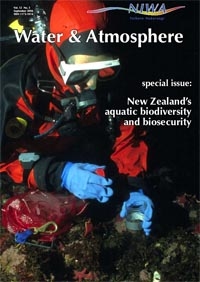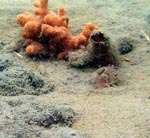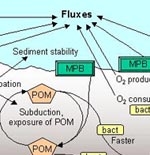PDF of this article (206 KB)

Drew Lohrer Nicole Hancock
Experimental work with sand and mud habitats highlights the importance of biodiversity from the bottom up.
Muddy and sandy sediments cover 70% of the world’s seafloor and are found in New Zealand harbours, estuaries and open coastal environments. Sediments have a reputation for being flat and brown, and are certainly less glamourous than the colourful rocky pinnacles, seamounts and coral reefs that get media attention. However, soft sediments host a diverse array of organisms and play a pivotal role in marine ecosystem functioning.


Sediments create a three-dimensional living environment for bottom-dwelling creatures, and animals can burrow deep within the sediment column (up to 2 m below the sediment surface in the case of some crabs and shrimps). This contrasts with rocky systems, where plants and animals are generally confined to hard, impermeable surfaces. Because sediment is an accumulation of particles that have settled to the seabed, it is generally rich in organic matter, with fresh new detritus continually falling to the seabed from above. Animals inhabiting the sediment use this organic detritus as a source of food, but may also graze on microscopic algae that grow on the sediment surface.
Fluxes summarise the system
The sediment–seawater interface is permeable, so water fills the small gaps between particles. This sedimentary pore water differs from the overlying seawater in many ways. The concentration of oxygen in pore water decreases rapidly with depth in the sediment, so animals living beneath the sediment surface must maintain access to an oxygen-rich supply. Also, concentrations of nutrients (released by the breakdown of organic matter by bacteria) are generally much greater in pore water than they are in overlying seawater. The nutrients in pore water act as a fertiliser for algal growth, and the algae can only flourish with a combination of both sunlight and essential nutrients. Thus enhanced rates of oxygen and nutrients flowing into and out of the sediment are likely to affect benthic animals and plants. These flows, called fluxes, are measurements of the quantity moved per area per time (for example, grams of nitrogen per m2 per day). We can learn a lot about how the soft-sediment seafloor functions by understanding the fluxes of oxygen and nutrients.
Although the sophistication of techniques used to measure fluxes has increased dramatically in recent years, the interpretation of flux data is still quite complicated, for many reasons. Soft sediments are inherently complex: bacteria, microalgae, and benthic invertebrates all influence oxygen and nutrient concentrations simultaneously, via direct and indirect pathways (see diagram, right). Fluxes are net results of all such interactions, some of which reinforce each other to increase or decrease flux, and some of which oppose each other. It takes a collaborative, interdisciplinary approach to understand the physical, geochemical, and ecological factors affecting flux rates: a lone scientist in any single discipline will likely overlook key elements in the system, and risk misinterpretation of results.
A biocomplexity framework
The study of fluxes in soft-sediment systems fits well into a “biocomplexity” framework. Biocomplexity is a new buzz word in the natural sciences which acknowledges the interactive (and interdisciplinary) feedback effects that are sometimes difficult to identify and quantify. Proponents of the biocomplexity concept cite the need to study whole systems, as they may exhibit special properties that are not predictable based on the sum of their component parts. Science that reduces complexity and confounding factors in carefully controlled field and laboratory experiments assumes, sometimes without basis, that results can be easily extrapolated to the real world.
Probing soft sediments
NIWA scientists in Hamilton have begun studying biocomplexity in soft sediments. The studies involve measurements of water chemistry over time, the raw data from which fluxes are calculated. However, experiments have also included manipulations of important physical and biological drivers (sunlight intensity, sediment mixing by large invertebrates) so we can separate out the effects of different interacting components in the system. Most importantly, we work with intact soft-sediment communities in order to capture the behaviour of the system as a whole. This requires scuba divers setting up equipment on the seafloor to capture the interactions within natural assemblages of bacteria, algae, and invertebrates. With three experiments run so far and others planned for next year, we are building our base of knowledge and learning how soft sediments perform in different seasons and with differing numbers of invertebrate individuals and species.
We know that disturbance to the seabed can remove key species and reduce biodiversity and that reductions in biological diversity may decrease ecosystem performance. By identifying good measures of ecosystem performance, NIWA scientists are now better positioned to make these linkages and inform coastal managers about the functional importance of marine soft sediments, the most widespread seafloor ecosystem on Earth.
Drew Lohrer and Nicole Hancock are based at NIWA in Hamilton.
Acknowledgement
This research was carried out as part of NIWA’s FRST-funded programmes “Fishing: Ecosystem Effects and Resource Sustainability” (C01X0212) and “Effects Based Protection and Management of Aquatic Ecosystems” (C01X0307).
Teachers: this article can be used for NCEA Achievement Standards in Biology 2.5, 3.2. See other curriculum connections at www.niwa.co.nz/pubs/wa/resources
